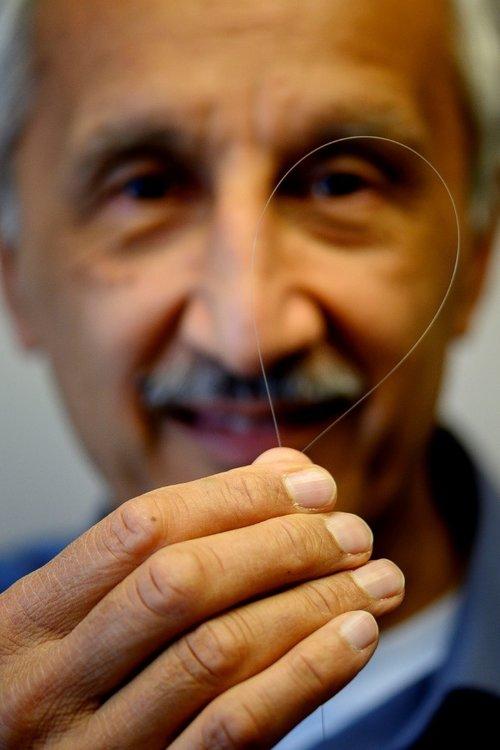
Credit: Jonathan Steffen/U.S. Naval Research Laboratory
WASHINGTON — Scientists at the U.S. Naval Research Laboratory have devised a new process for using nano-particles to build powerful lasers that are more efficient and safer for your eyes.
They’re doing it with what’s called “rare-earth-ion-doped fiber.” Put simply, it’s laser light pumping a silica fiber that has been infused with rare earth ions of holmium. According to Jas S. Sanghera, who heads the Optical Materials and Devices Branch, they have achieved an 85 percent efficiency with their new process.
“Doping just means we’re putting rare earth ions into the core of the fiber, which is where all the action happens,” Sanghera explained. “That’s how we’ve produced this world record efficiency, and it’s what we need for a high-energy, eye-safer laser.”
According to Colin Baker, research chemist with the Optical Materials and Devices Branch, the lasing process relies on a pump source–most often another laser–which excites the rare earth ions, which then emit photons to produce a high quality light for lasing at the desired wavelength.
“But this process has a penalty,” Baker said. “It’s never 100 percent efficient. What you’re putting in is pump energy, not the high quality light at the wavelength you want. What’s coming out is a much higher quality of light at the specific wavelength that you want, but the remaining energy that isn’t converted into laser light is wasted and converted into heat.”
That loss of energy, Baker said, ultimately limits power scaling and the quality of the laser light, which makes efficiency especially important.
With the aid of a nano-particle ‘dopant,’ they’re able to achieve the 85 percent level of efficiency with a laser that operates at a 2 microns wavelength, which is considered an “eye-safer” wavelength, rather than the traditional 1 micron. Of course, Baker pointed out, no laser can be said to be safe when it comes to the human eye.
The danger arises from the potential of scattered light to be reflected into the eye during a laser’s operation. Scattered light from the path of a 100-kilowatt laser operating at 1 micron can cause significant damage to the retina, leading to blindness. With an eye-safer laser, operated at wavelengths beyond 1.4 micron, however, the danger from scattered light is considerably lessened.
According to Baker, the nano-particle doping also solves several other problems, such as that it shields the rare earth ions from the silica. At 2 microns, the silica’s glassy structure can reduce the light output from the rare earth ions. The nanoparticle doping also separates the rare earth ions from each other, which is helpful since packing them closely together can also reduce the light output.
(Traditional lasers that operate at 1 micron, using an ytterbium dopant, aren’t nearly as affected by these factors, Baker said.)
“The solution was some very clever chemistry that dissolved holmium in a nano-powder of lutetia or lanthanum oxide or lanthanum fluoride to create a suitable crystal environment [for the rare earth ions],” ,” Sanghera said. “Using bucket chemistry to synthesize this nano-powder was key in keeping the cost down.”
The particles of the nano-particle powder, which Sanghera’s team had originally synthesized for a previous project, are typically less than 20 nanometers, which is 5,000 times smaller than a human hair.
“Additionally, we had to be able to successfully dope these nano-powders into the silica fiber in quantities that would be suitable to achieve lasing,” he added.
At the Optical Materials and Devices Branch, Sanghera’s team of scientists are working with a room-sized, glass-working lathe, where the glass that will eventually become the fiber is cleaned with fluorine gases, molded with a blow torch and infused with the nano-particle mixture – what the scientists call a “nanoparticle slurry.” The result is a rare-earth-ion-doped, one-inch diameter, glass rod, or “optical preform.”
Next door, scientists use a fiber pulling system–a tower so massive that it takes up two large rooms and; the height of two floors of the building–to soften the preform with a furnace and elongate it, in a process akin to pulling taffy, into an optical fiber about as thin as a human hair, which then spools onto a nearby large spindle.
Sanghera’s team has already submitted a patent application for the process. Among the potential applications they envision for the new specialty fiber laser are high powered lasers and amplifiers for defense, telecommunications and even welding and laser-cutting.
“From a fundamental perspective, the whole process is commercially viable,” Sanghera said. “It’s a low-cost process to make the powder and incorporate it into the fiber. The process is very similar to making telecom fiber.”
###
Media Contact
Emanuel Cavallaro
[email protected]
Original Source
https:/



